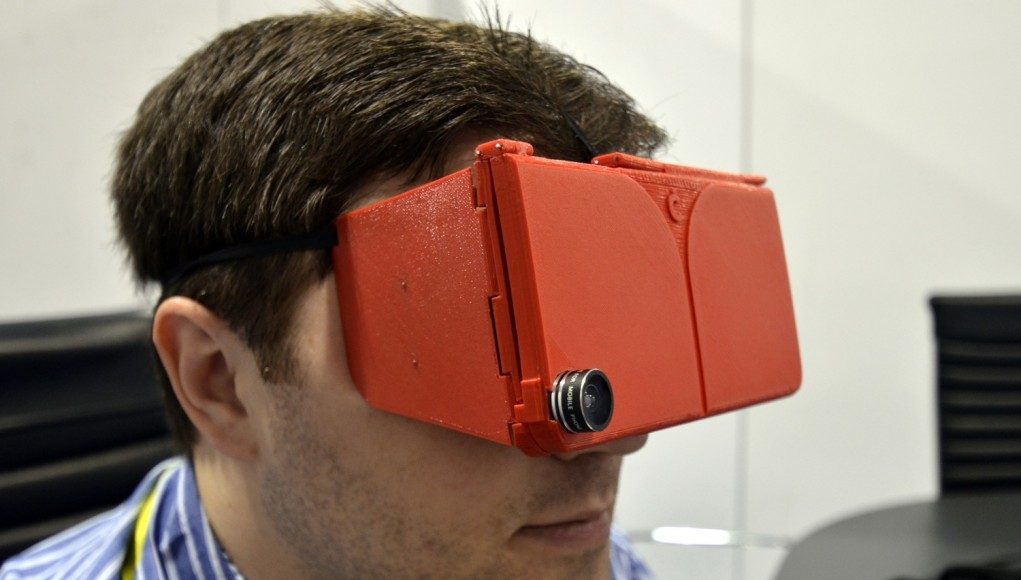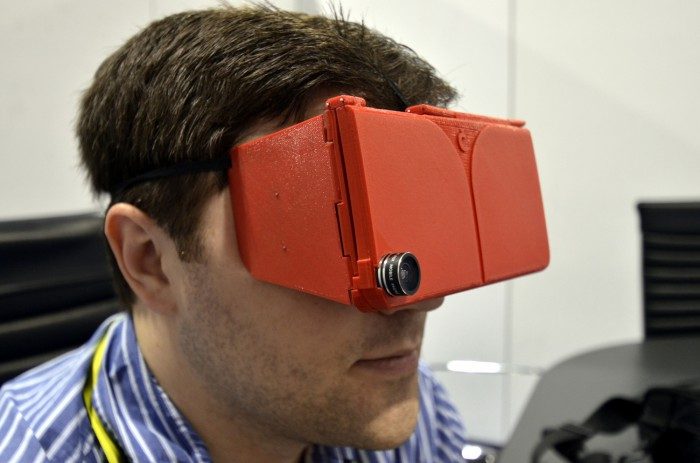 ‘The best camera is the one that’s always with you,’ so goes the saying. The folks from Cordon, a Canadian digital agency, are hoping that the same will be true about virtual reality; that’s why they’re making a smartphone case that transforms into a VR headset. I recently got to check out one of their early prototypes. At CES 2015 I spoke with Milan Baic, Founder and Director of Digital Strategy at Cordon, and Corey Herscu from HerscuPR, a PR agency working with Cordon. Cordon is running an Indiegogo crowdfunding campaign to produce Pinć VR (pronounced “Pinch”), which also encompass an interactive gesture-controlled VR environment for iOS and Android. The headset appeals to my desire to have a virtually large productivity space in a physically limited space, like on a bus or a plane.
‘The best camera is the one that’s always with you,’ so goes the saying. The folks from Cordon, a Canadian digital agency, are hoping that the same will be true about virtual reality; that’s why they’re making a smartphone case that transforms into a VR headset. I recently got to check out one of their early prototypes. At CES 2015 I spoke with Milan Baic, Founder and Director of Digital Strategy at Cordon, and Corey Herscu from HerscuPR, a PR agency working with Cordon. Cordon is running an Indiegogo crowdfunding campaign to produce Pinć VR (pronounced “Pinch”), which also encompass an interactive gesture-controlled VR environment for iOS and Android. The headset appeals to my desire to have a virtually large productivity space in a physically limited space, like on a bus or a plane.
I went into my meeting with Cordon thinking that Pinć VR was a mere concept, but was surprised instead to find a functional prototype. What Baic and Herscu showed me was a somewhat crude 3D printed device, but it was already functional as case/headset with pop-up lenses, support flaps, a headstrap, and even a VR-ready demo with headtracking—and it already folds down into a 15mm thick package (including the phone), that’s surprisingly pocketable.  The case starts all closed up and looks mostly like a bulky smartphone case. To transform into a VR headset, a hinged segment hanging on the back of the case flips around to the front, covering the screen. Upon opening the flaps on the top of that segment, you’ll find lenses that pop up and are held in place with a flexible material, and a headstrap made of thin latex-like plastic.
The case starts all closed up and looks mostly like a bulky smartphone case. To transform into a VR headset, a hinged segment hanging on the back of the case flips around to the front, covering the screen. Upon opening the flaps on the top of that segment, you’ll find lenses that pop up and are held in place with a flexible material, and a headstrap made of thin latex-like plastic.
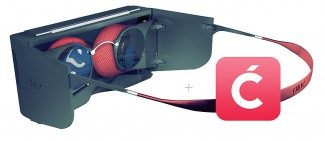
With a desire to keep things slim, the Pinć VR headset is using Fresnel lenses which can provide optical characteristics of larger lenses without the bulk (not without the potential for downsides, though that’s somewhat of a long running debate). Looking through the lenses revealed an image that was quite blurry, though it wasn’t clear if this was the result of the Fresnel nature of the lenses, lens quality, or lens cleanliness. It could have also been an issue with lens-to-screen distance and orientation— mounting lenses on a flexible material will certainly present a challenge in that regard. Surely making sure the lens deployment is consistent every time will be key to Pinć VR’s success, and I gather that the team is well aware—renders of the device show what looks to be a more substantial lens mounting mechanism than what I saw on this early prototype. What I was able to see was a headtracked VR environment that was mostly black with some floating interface elements. In addition to the case, Pinć VR is intended to include to ‘pincher’ ring controllers (one around a finger on the left and right hand), but unfortunately Baic and Herscu had misplaced them at some point in the madness of CES so I wasn’t able to see how far they are when it comes to input and UI. 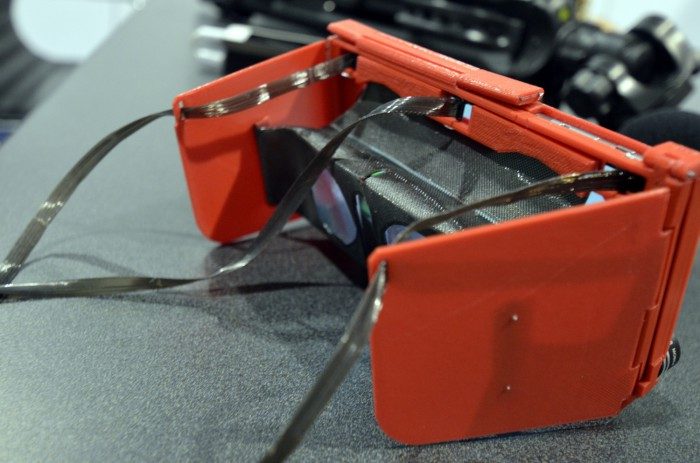 At first I thought the plastic/rubber headstrap would be fragile. I didn’t even go to put the thing on my head before asking to be sure it wasn’t just a placeholder. After affirmation from Baic, I put it on and realized that the material was actually quite strong. For now the headstrap just kind of flaps around in the way, but Baic told me that the plan is to have some sort of retracting reel mechanism, or perhaps something different altogether (renders of the device show glasses-style temple struts that go over the ears).
At first I thought the plastic/rubber headstrap would be fragile. I didn’t even go to put the thing on my head before asking to be sure it wasn’t just a placeholder. After affirmation from Baic, I put it on and realized that the material was actually quite strong. For now the headstrap just kind of flaps around in the way, but Baic told me that the plan is to have some sort of retracting reel mechanism, or perhaps something different altogether (renders of the device show glasses-style temple struts that go over the ears).  The headstrap in its current form actually worked relatively well for holding the device to my face. Even though the straps are quite thin, my brief time with the headset didn’t reveal any major issues, probably thanks to the unit’s mere 110g weight (259g if counting an iPhone 6 Plus).
The headstrap in its current form actually worked relatively well for holding the device to my face. Even though the straps are quite thin, my brief time with the headset didn’t reveal any major issues, probably thanks to the unit’s mere 110g weight (259g if counting an iPhone 6 Plus).
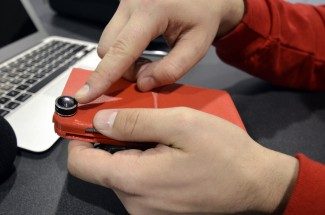
In the end, the software side of Pinć VR seems highly ambitious—essentially a free-air gesture-based AR/VR interface—and I’ll have to see it for myself before having a good idea of whether or not Cordon could manage such a task. Even without a first-party software component, a fully functional and pocketable VR headset that’s always with you could be a big win.

